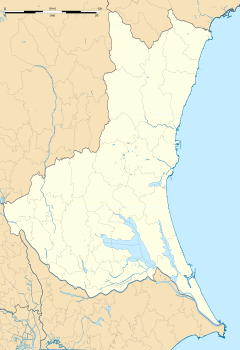Isohara Station
This article needs additional citations for verification. (January 2017) |
Isohara Station 磯原駅 | ||||||||||||||||
|---|---|---|---|---|---|---|---|---|---|---|---|---|---|---|---|---|
 Isohara Station in May 2008 | ||||||||||||||||
| General information | ||||||||||||||||
| Location | 759 Isohara, Isohara-cho, Kitaibaraki-shi, Ibaraki-ken 319-1541 Japan | |||||||||||||||
| Coordinates | 36°47′27″N 140°44′45″E / 36.7907°N 140.7458°E | |||||||||||||||
| Operated by | ||||||||||||||||
| Line(s) | ■ Joban Line | |||||||||||||||
| Distance | 171.6 km from Nippori | |||||||||||||||
| Platforms | 2 side platforms | |||||||||||||||
| Other information | ||||||||||||||||
| Status | Staffed | |||||||||||||||
| Website | Official website | |||||||||||||||
| History | ||||||||||||||||
| Opened | 25 February 1897 | |||||||||||||||
| Passengers | ||||||||||||||||
| FY2019 | 1697 daily | |||||||||||||||
| Services | ||||||||||||||||
| ||||||||||||||||
| Location | ||||||||||||||||
Isohara Station (磯原駅, Isohara-eki) is a passenger railway station in the city of Kitaibaraki, Ibaraki Prefecture, Japan, operated by East Japan Railway Company (JR East).
Lines[edit]
Isohara Station is served by the Joban Line, and is located 171.6 km from the official starting point of the line at Nippori Station.
Station layout[edit]
The station consists of two elevated opposed side platforms. The station building is elevated to the level of the platforms; however, connection between the platforms is made an overhead walkway. The station is staffed. Nanatsu no Ko is used as the departure melody.[1]
Platforms[edit]
| 1 | ■ Joban Line | for Takahagi, Hitachi, Katsuta, Mito, Tomobe, Ishioka and Tsuchiura |
| ■ Jōban Line (Limited Express) | for Takahagi, Mito, Ueno, Tokyo and Shinagawa | |
| 2 | ■ Jōban Line | for Iwaki, Tomioka, Namie and Haranomachi |
| ■ Jōban Line (Limited Express) | for Iwaki and Sendai |
History[edit]
Isohara Station was opened on 25 February 1897. The station was absorbed into the JR East network upon the privatization of Japanese National Railways (JNR) on 1 April 1987. It was rebuilt as an elevated station building in October 1997.[citation needed]
Passenger statistics[edit]
In fiscal 2019, the station was used by an average of 1697 passengers daily (boarding passengers only).[2]
Surrounding area[edit]
- Kita-Ibaraki Post Office
 National Route 6
National Route 6- Isohara Industrial Park
See also[edit]
References[edit]
- ^ https://www.youtube.com/watch?v=VhZ9dYzAJbI 7.11.2009
- ^ 各駅の乗車人員 (2019年度) [Station passenger figures (Fiscal 2019)] (in Japanese). Japan: East Japan Railway Company. 2020. Retrieved 11 August 2020.
External links[edit]
 Media related to Isohara Station at Wikimedia Commons
Media related to Isohara Station at Wikimedia Commons- Official website (in Japanese)


